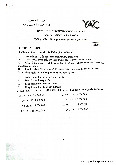



















Preview text:
Chapter 1. Basic conceptions in statistics Chapter 1 - Content
• 1.1 What is statistics? The goal of statistics.
• 1.2 Basis conceptions in statistics.
• 1.3 Classification of data and variables
• 1.4 Types of measurement scale.
• 1.5 Descriptive statistics and statistical inference. 8 What is statistics?
The term statistics can refer to numerical facts
such as averages, medians, percents, and index
numbers that help us understand a variety of
business and economic situations.
Statistics can refer to the science of collecting,
organizing, and analyzing data.
The goal of statistics is to gain understanding from data. 9
1.2 Basic conceptions in statistics
In this part, we are going to learn some conceptions: • Data and data set • Population • Sample • Element • Observation • Variable. 10 Data and Data Sets
• Data are the pieces of information or figures
collected, analyzed, and summarized for
presentation and interpretation.
• All the data collected in a particular study are
referred to as the data set for the study. 11 Population, Sample, Element, Observations, and Variables -1 Population:
A population is an entire group you are interested in studying.
You can think of a population as a collection of persons,
things, or objects under study. Sample:
A sample is a subset of the population. 12 Population, Sample, Element, Observations, and Variables -1 Example 1:
Mrs. Smith wants to do a statistical analysis on
students' final examination scores in her math class for the past year.
Should she consider her data to be a population data set or a sample data set?
ANS: She has all of the data that pertains (liên quan đến)
to her investigation -> population. 12 Population, Sample, Element, Observations, and Variables -2 Example 2:
A group of students surveys 100 students from their
freshman class to determine the number of pets in each student's household.
The group plans to compute statistical findings on their
data and generalize these findings to the homes of all freshmen students.
Should the group consider their data to be a population data set or a sample data set? 12 Population, Sample, Element, Observations, and Variables -3
Elements are the entities on which data are collected.
A variable is a characteristic of interest for the elements.
• The set of measurements obtained for a particular
element is called an observation.
• A data set with n elements contains n observations. 9
Example: Elements, Variables, and Observations -4 Element Names Variables
• the data set contains 8 elements.
• five variables: WTO status, Per Capita GDP($), Trade
Deficit ($1000s), Fitch Rating, Fitch Outlook.
• observations: the first observation (Armenia)
Member, 5400, 2673359, BB-, Stable. 10 1.3 Classification of data -1
Categorical/qualitative data:
Qualitative data take on values that are names or labels.
Examples: The color of a ball (e.g., red, green,…), gender (male or female), Quantitative data:
take on values that are numeric.
They present a measurable quantity.
Examples: the number of students attending in the class,
heights (in centimeter) of female student in the class. 11 1.3 Classification of data -2
Classify data as quantitative or categorical.
Daytime temperature readings (in degrees
Fahrenheit) in a 30-day period.
Heights (in centimeters) of plants in a plot of land.
Number (0, 1, 2, or so on) of people attending a conference.
Names (first and last) of a group of students who took an exam. 12 1.4 Scales of Measurement -1
data can be classified as being on one of
four scales: nominal, ordinal, interval, and ratio.
Nominal scale is used for labeling categorical data.
Nominal scale is the measurement scale in which the
numbers serve as “tags” or “labels” to classify or identify the objects/categories.
The numbers do not define the object characteristics. The
only permissible aspect of numbers in the nominal scale is “counting”. 13 1.4 Scales of Measurement -2
A good way to remember all of this is that “nominal”
sounds like “name” and nominal scale is kind of like “names” or “labels”. • Here are some examples: 14 1.4 Scales of Measurement -3
Ordinal scale is used for labeling categorical data.
In the ordinal scale, numbers present “greater than” or
“less than” measurement, such as preferences or ranking.
With ordinal scale, the order of the values is what’s
important and significant, but the differences between two objects is not really know. 15 1.4 Scales of Measurement -4 16 1.4 Scales of Measurement -5
“Ordinal” is easy to remember because it sounds
like “order” and that is the key to remember “ordinal scale”. 17 1.4 Scales of Measurement -6
The interval scale has properties of ordinal scale with
the interval between observations is expressed in terms of . .
The difference between two adjacent points is called unit of measure.
The interval scale allows us to describe “how much more
or less” one observation than another. 18 1.4 Scales of Measurement -7
The interval scale doesn’t have a “true zero”.
Zero value is a convention. Thus, ratios of values of the variable are not meaningful. .
With interval data, we can add and subtract, but can not multiply or divide. 19 1.4 Scales of Measurement -8
The centigrade temperature scale represents
an interval scale of measurement.
The distance between two adjacent points on this scale is Temperature can be below + = . No problem is not twice as hot as ” 20



